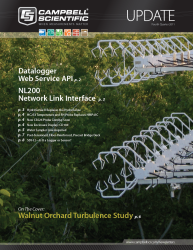We are pleased to announce that Campbell Scientific has acquired the Sirco line of water samplers from Southwell Corporation in Canada. Sirco samplers have a 30-year history of successful operation in stormwater, wastewater, and other waterquality applications. As stand-alone water samplers, these products already meet a variety of sampling needs. As we integrate them with our existing data acquisition, telemetry, and sensor products, we will provide even more solutions for monitoring and control applications.
Our search for a high-quality water sampler began a couple of years ago and it didn’t take long to find Sirco samplers. After distributing them for a while, we decided to make them a permanent addition to our product line as Campbell Scientific water samplers. The acquisition was finalized earlier this year, and we have successfully transferred the entire manufacturing operation to our headquarters in Logan, Utah. We have been manufacturing samplers since late summer.
The future is bright for these samplers. They are already capable of being programmed on their keypad for time-based, pulse-induced, 4 to 20 mA-input, and flow-based samples. We plan to extend their usefulness even more by integrating them with rain gages, turbidity probes, pressure transducers, and telemetry devices—on top of the power, logic, and communications protocols (e.g., Modbus, DNP3, TCP/IP) provided by our dataloggers.
One of the biggest advantages of these samplers is that they use external vacuum pumps to draw water through intake tubing, instead of the traditional peristaltic pumps that induce flow by squeezing flexible tubing. Advantages of the vacuumpump method include faster sampling rates, better vertical lifts, longer sampling distances, more-precise volume control between samples, and less maintenance. Because the vacuum method disturbs water samples less, they better represent the original water solution, especially if the solution has high concentrations of suspended solids. To prevent cross contamination, the samplers use air pressure (up to 28 psi) to purge the tubing of excess water.
The new product line includes many different options for both portable and stationary samplers. The PVS4150, PVS4120, and PVS4100 are portable, battery-operated water samplers. Designed for easy transport, the PVS4150 includes wheels, a telescoping handle, and a rugged case. The PVS4120 is the lightest sampler, weighing only 27 lb. The PVS4100 has a bigger pump that supports the fastest sampling rates, highest vertical lifts, and longest sampling distances. It also can use wider tubing (5/8-in. ID), which is better for handling large solids. All the portable models include space for ice to keep samples cool.
The CVS4200 and BVS4300 are stationary, ac-powered water samplers for wastewater applications. They use the same big pump as the PVS4100 and support all of its capabilities. The CVS4200 is an indoor sampler that has a corrosion-resistant steel enclosure. The BVS4300 is an outdoor sampler designed to handle extreme environments. It has a corrosion-resistant steel enclosure with a locking door and bolted-down instrument panel. All of the stationary samplers have a refrigerator option to keep the samples at the EPArecommended temperature of 4º C. They can also be equipped with insulation, circulating fans, and heaters as needed.
Both composite and discrete options are available in both portable and stationary models. Composite samplers take samples, then deliver them into the same container each time. Discrete samplers collect samples and deliver them to different containers, from 500 ml to 1000 ml.
We are excited about the possibilities these samplers bring to water-quality applications. Don’t hesitate to provide us with your input as we carry this great product line into the future.

